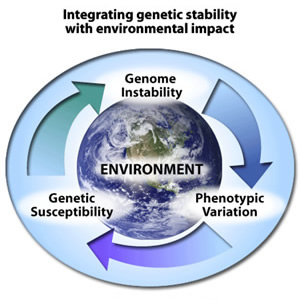 |
|
Repair, Replication & Checkpoint Function Michael A. Resnick, Ph.D.
Principal Investigator Tel (919) 541-4480 Fax (919) 541-7593 resnick@niehs.nih.gov P.O. Box 12233 Mail Drop D3-01 Research Triangle Park, North Carolina 27709 Delivery Instructions Research SummaryThe Chromosomal Stability Group integrates mechanisms and genetic controls of genome stability with environmental factors and stress responses to better understand their complex contributions to human health. 
Photo of earth showing a circular flow chart with three concepts: genetic instability, phenotypic variation and genetic susceptibility.
Using budding yeast and human cell models, research focuses on genome maintenance and natural or environmental challenges to chromosome stability. Because of similarities in genome organization, enzymatic processes and genetic controls, findings are often applicable to human disease. Repair, replication and checkpoint functions are investigated to understand sources of genome instability and mechanisms of coping with DNA damage, particularly double-strand breaks. The functionality of human genes and networks that provide orderly developmental and stress responses are examined in these processes. The group develops a variety of highly sensitive systems for identifying subtle genome variations and responses that extend from chromosomal at-risk motifs (ARMs) to regulated transactivation by human master regulators. The Chromosome Stability Group's important contributions to human genome research were also featured in an article published in the NIEHS Environmental Factor. Major areas of research:
Current projects:
Michael A. Resnick, Ph.D., head of the Chromosome Stability Group within the Laboratory of Molecular Genetics, received his B.A. from Northwestern University in 1964 and his Ph.D. from the University of California, Berkeley, in 1968. Resnick completed postdoctoral fellowships with the Medical Research Council in London and Oak Ridge National Laboratories. He held faculty positions at the University of Rochester, New York, the National Institute for Medical Research, Mill Hill, London, and has been with NIEHS since 1979. He has authored over 125 peer-reviewed articles, many in leading biomedical journals, approximately 40 book chapters and co-edited several multi-contribution publications. His group was recognized with the "NIEHS Best Paper of the Year" award in 2003 and 2004. |
|

